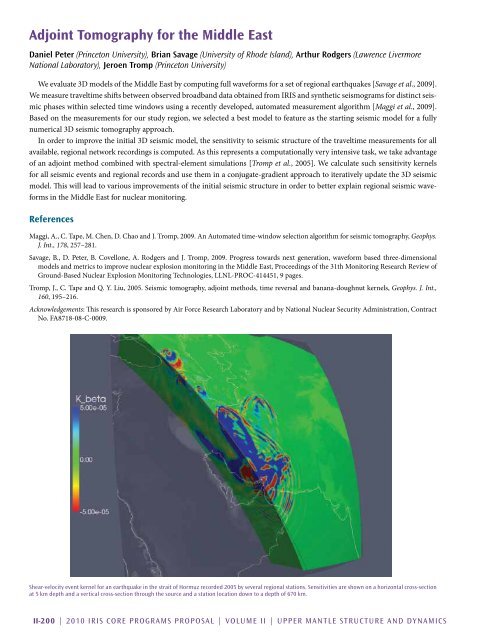Download Volume II Accomplisments (28 Mb pdf). - IRIS
Download Volume II Accomplisments (28 Mb pdf). - IRIS
Download Volume II Accomplisments (28 Mb pdf). - IRIS
Create successful ePaper yourself
Turn your PDF publications into a flip-book with our unique Google optimized e-Paper software.
Adjoint Tomography for the Middle East<br />
Daniel Peter (Princeton University), Brian Savage (University of Rhode Island), Arthur Rodgers (Lawrence Livermore<br />
National Laboratory), Jeroen Tromp (Princeton University)<br />
We evaluate 3D models of the Middle East by computing full waveforms for a set of regional earthquakes [Savage et al., 2009].<br />
We measure traveltime shifts between observed broadband data obtained from <strong>IRIS</strong> and synthetic seismograms for distinct seismic<br />
phases within selected time windows using a recently developed, automated measurement algorithm [Maggi et al., 2009].<br />
Based on the measurements for our study region, we selected a best model to feature as the starting seismic model for a fully<br />
numerical 3D seismic tomography approach.<br />
In order to improve the initial 3D seismic model, the sensitivity to seismic structure of the traveltime measurements for all<br />
available, regional network recordings is computed. As this represents a computationally very intensive task, we take advantage<br />
of an adjoint method combined with spectral-element simulations [Tromp et al., 2005]. We calculate such sensitivity kernels<br />
for all seismic events and regional records and use them in a conjugate-gradient approach to iteratively update the 3D seismic<br />
model. This will lead to various improvements of the initial seismic structure in order to better explain regional seismic waveforms<br />
in the Middle East for nuclear monitoring.<br />
References<br />
Maggi, A., C. Tape, M. Chen, D. Chao and J. Tromp, 2009. An Automated time-window selection algorithm for seismic tomography, Geophys.<br />
J. Int., 178, 257–<strong>28</strong>1.<br />
Savage, B., D. Peter, B. Covellone, A. Rodgers and J. Tromp, 2009. Progress towards next generation, waveform based three-dimensional<br />
models and metrics to improve nuclear explosion monitoring in the Middle East, Proceedings of the 31th Monitoring Research Review of<br />
Ground-Based Nuclear Explosion Monitoring Technologies, LLNL-PROC-414451, 9 pages.<br />
Tromp, J., C. Tape and Q. Y. Liu, 2005. Seismic tomography, adjoint methods, time reversal and banana-doughnut kernels, Geophys. J. Int.,<br />
160, 195–216.<br />
Acknowledgements: This research is sponsored by Air Force Research Laboratory and by National Nuclear Security Administration, Contract<br />
No. FA8718-08-C-0009.<br />
Shear-velocity event kernel for an earthquake in the strait of Hormuz recorded 2005 by several regional stations. Sensitivities are shown on a horizontal cross-section<br />
at 5 km depth and a vertical cross-section through the source and a station location down to a depth of 670 km.<br />
<strong>II</strong>-200 | 2010 <strong>IRIS</strong> Core Programs Proposal | <strong>Volume</strong> <strong>II</strong> | Upper Mantle Structure and Dynamics
















